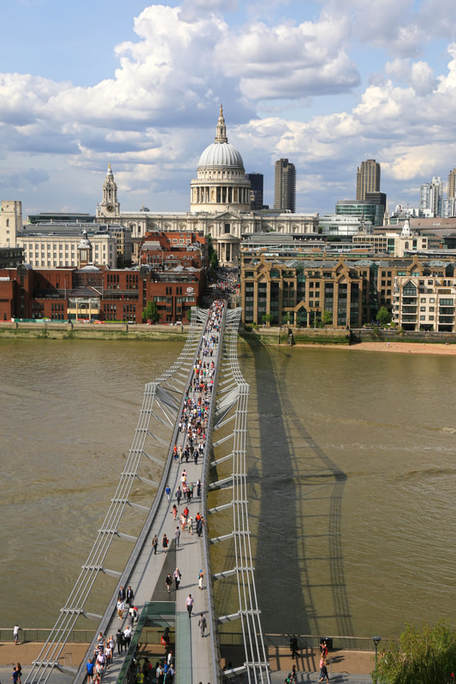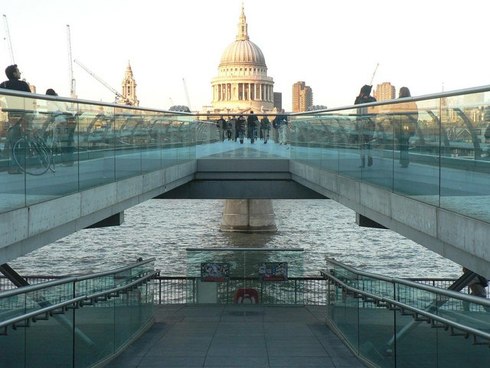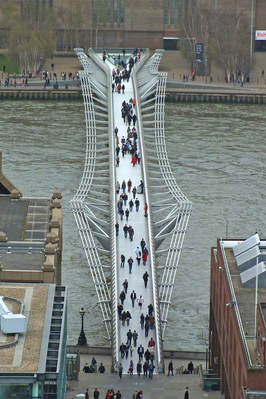 By Jan Kameníček [CC BY-SA 3.0 (https://creativecommons.org/licenses/by-sa/3.0)], from Wikimedia Commons
By Jan Kameníček [CC BY-SA 3.0 (https://creativecommons.org/licenses/by-sa/3.0)], from Wikimedia Commons
On June 10 of the year 2000, the Millennium Bridge in London opened to the public for use as a footbridge over the Thames river, linking St. Paul's Cathedral on the north bank to Tate Modern and Shakespeare's Globe Theater on the south bank. It was the first new crossing of the Thames river in central London in more than 100 years. Touted as a work of art, an engineering marvel and a social statement, the Millenium Bridge had been designed by a collaboration of some of the world's most prestigious architects and engineers, namely the noted architect Lord Norman Foster and his firm, Foster + Partners, the famous sculptor Sir Anthony Caro and the accomplished Ove Arup and Partners.
What made the Millennium Bridge so unique was that it was a new type of bridge called a horizontal suspension bridge. A conventional suspension bridge has a deck supported by vertical suspender cables hanging from sagging main suspension cables. In contrast, the Millennium Bridge had a deck supported by main suspension cables that were disposed just above the deck and on opposing sides thereof. In fact, at midspan, the main suspension cables dipped below the deck to give an unimpeded view of London. There was very little sag in the eight suspension cables (four on each side), which required them to be under an incredible amount of tension.
The deck of the Millennium Bridge was constructed from shiny aluminum and the handrails were made from stainless steel. At night, the bridge was illuminated with state-of-the-art fiberoptic lighting. The result of the bridge's unique construction was dramatic and beautiful. As noted by Foster + Partners, the Millennium Bridge appeared as "a fine metal ribbon by day, and a blade of light by night".
What made the Millennium Bridge so unique was that it was a new type of bridge called a horizontal suspension bridge. A conventional suspension bridge has a deck supported by vertical suspender cables hanging from sagging main suspension cables. In contrast, the Millennium Bridge had a deck supported by main suspension cables that were disposed just above the deck and on opposing sides thereof. In fact, at midspan, the main suspension cables dipped below the deck to give an unimpeded view of London. There was very little sag in the eight suspension cables (four on each side), which required them to be under an incredible amount of tension.
The deck of the Millennium Bridge was constructed from shiny aluminum and the handrails were made from stainless steel. At night, the bridge was illuminated with state-of-the-art fiberoptic lighting. The result of the bridge's unique construction was dramatic and beautiful. As noted by Foster + Partners, the Millennium Bridge appeared as "a fine metal ribbon by day, and a blade of light by night".
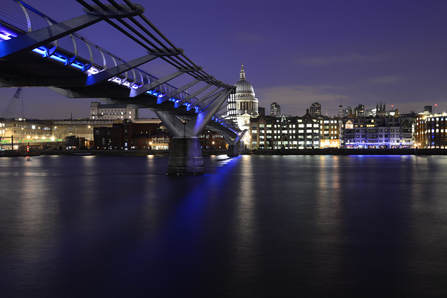 By Aleem Yousaf (Millennium Bridge and St Pauls Cathedral) [CC BY-SA 2.0 (https://creativecommons.org/licenses/by-sa/2.0)], via Wikimedia Commons
By Aleem Yousaf (Millennium Bridge and St Pauls Cathedral) [CC BY-SA 2.0 (https://creativecommons.org/licenses/by-sa/2.0)], via Wikimedia Commons
Another engineering marvel, the Öresund Bridge connecting Denmark to Sweden, was set to open a month after the Millennium Bridge. Just before the opening of the Millennium Bridge, one British observer compared the Millennium Bridge with the Öresund Bridge, stating that: "The Millennium Bridge is David to the Oresund Link's Goliath, but it is in the subtlety, indeed the revolutionary nature of its design, that it wins hands down over the Viking bridge's bludgeoning, battleaxe engineering."
On Saturday, June 10, 2000, the Millennium Bridge opened with a sponsored walk in support of Save the Children. Afterwards, the bridge opened to the public. Thousands streamed across the fine metal ribbon, experiencing the sights and sounds of London and something else, something more physical. The bridge started swaying as people walked across the deck! In response to the swaying, people changed their gate to accommodate the movement, which only exacberated the problem. Soon the bridge was swaying and twisting so much that pedestrians began to experience motion sickness. While the bridge was not in danger of collapsing, it was enough to cause the authorities to close the bridge only two days after opening. The Millennium Bridge now became known as the Wobbly Bridge. Maybe battleaxe engineering wasn't so bad after all.
Engineers undertook a study of the Millennium Bridge to determine what was causing the excessive swaying. At first, they thought it was the wind catching all the banners and flags adorning the bridge for its grand opening, but soon realized this was not the case. They eventually determined that the lateral component of walking was the culprit. As it turns out, a typical person exerts a lateral force of about 25N when they take a step, which occurs on average about once per second. As such, walking applies lateral forces at a frequency of 1 Hz. This frequency happened to be one of the natural frequencies of sideways motion of the center span of the Millenium Bridge. When a large enough crowd of people walked on the bridge, the combined lateral forces of their steps set the bridge in motion.
On Saturday, June 10, 2000, the Millennium Bridge opened with a sponsored walk in support of Save the Children. Afterwards, the bridge opened to the public. Thousands streamed across the fine metal ribbon, experiencing the sights and sounds of London and something else, something more physical. The bridge started swaying as people walked across the deck! In response to the swaying, people changed their gate to accommodate the movement, which only exacberated the problem. Soon the bridge was swaying and twisting so much that pedestrians began to experience motion sickness. While the bridge was not in danger of collapsing, it was enough to cause the authorities to close the bridge only two days after opening. The Millennium Bridge now became known as the Wobbly Bridge. Maybe battleaxe engineering wasn't so bad after all.
Engineers undertook a study of the Millennium Bridge to determine what was causing the excessive swaying. At first, they thought it was the wind catching all the banners and flags adorning the bridge for its grand opening, but soon realized this was not the case. They eventually determined that the lateral component of walking was the culprit. As it turns out, a typical person exerts a lateral force of about 25N when they take a step, which occurs on average about once per second. As such, walking applies lateral forces at a frequency of 1 Hz. This frequency happened to be one of the natural frequencies of sideways motion of the center span of the Millenium Bridge. When a large enough crowd of people walked on the bridge, the combined lateral forces of their steps set the bridge in motion.
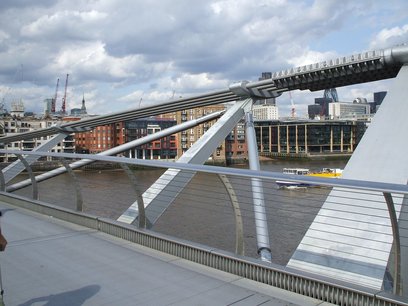 By Dave Farrance [CC BY-SA 3.0 (https://creativecommons.org/licenses/by-sa/3.0) or GFDL (http://www.gnu.org/copyleft/fdl.html)], from Wikimedia Commons
By Dave Farrance [CC BY-SA 3.0 (https://creativecommons.org/licenses/by-sa/3.0) or GFDL (http://www.gnu.org/copyleft/fdl.html)], from Wikimedia Commons
In order to prevent swaying, engineers installed a dampening system that included eight tuned mass dampers and 37 viscous dampers. The mass dampers were 2.5 ton steel blocks suspended on pendulums, which vibrated 180º out of phase with the bridge. The viscous dampers (shown to the right) operated similar to automobile shock absorbers and were used to dampen most of the lateral motion. The dampening system successfully stopped 97% of the motion of the bridge.
On February 27, 2002, the Millennium Bridge reopened and has remained opened since, except for a temporary closing in 2007 due to a bad storm. It has become a popular London tourist attraction, especially for Harry Potter fans. In the 2009 movie Harry Potter and the Half-Blood Prince, the Millennium Bridge is shown being destroyed by Death Eaters (and not excessive oscillation).
The Millennium Bridge truly is an elegant work of art and provides a number of impressive and intriguing views of its environs, one of which is shown below. The problems that were encountered and the manner in which they were successfully resolved demonstrate what engineering is all about and have advanced the body of knowledge on bridge design, to the benefit of all.
On February 27, 2002, the Millennium Bridge reopened and has remained opened since, except for a temporary closing in 2007 due to a bad storm. It has become a popular London tourist attraction, especially for Harry Potter fans. In the 2009 movie Harry Potter and the Half-Blood Prince, the Millennium Bridge is shown being destroyed by Death Eaters (and not excessive oscillation).
The Millennium Bridge truly is an elegant work of art and provides a number of impressive and intriguing views of its environs, one of which is shown below. The problems that were encountered and the manner in which they were successfully resolved demonstrate what engineering is all about and have advanced the body of knowledge on bridge design, to the benefit of all.


